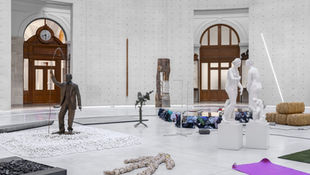
Aesthetics and Functionality
Furniture design stands as a bridge between art and utility, where the pursuit of aesthetic expression often intertwines with the demand for functional performance. In this context, the tension and harmony between aesthetics and functionality have become central to the discourse in design theory and practice. The design of furniture involves not just the creation of visually pleasing objects but also the careful consideration of how these objects interact with their environment, support human activities, and address the practical needs of the user. This article explores the dual importance of aesthetics and functionality in furniture design, emphasising their interdependence and the challenges that arise when balancing these often competing elements.

Aesthetics in furniture design pertains to the visual and sensory experience that an object offers to its observer. This includes form, colour, texture, proportion, and the overall visual appeal of the piece. Designers often draw on historical styles, cultural references, and personal artistic expression to create pieces that resonate emotionally with users. The aesthetic component of furniture design serves several functions: it contributes to the atmosphere of a space, reflects the identity or values of the user, and provides an emotional experience that is tied to beauty, comfort, or novelty. A well-designed piece of furniture can evoke a sense of harmony, evoke memories, or stir emotions, creating a bond between the user and the object. However, the aesthetic dimension of furniture design is not just about superficial beauty. It is also about the thoughtful consideration of how the form and visual language of an object relate to the larger space in which it resides. For instance, the minimalist aesthetic of mid-century modern furniture does not just appeal to modern sensibilities but is also deeply connected to the changing social dynamics and technological advancements of its time. Aesthetic choices reflect cultural shifts, societal values, and the design philosophy of the period in which a piece is created. As such, aesthetics in furniture design is often inextricably tied to broader social and cultural narratives, making it a reflection of the time and place from which it emerges.
On the other hand, functionality is the aspect of furniture design that focuses on the practical and utilitarian aspects of a piece. It involves considerations of ergonomics, user comfort, durability, usability, and space efficiency. The primary function of furniture is to support human activities, whether it is sitting, working, storing, or relaxing. The effectiveness of a design is, in large part, determined by how well it meets the needs and expectations of the user. For example, a chair must support the human body in a way that minimises discomfort, promotes good posture, and accommodates varying body types. Similarly, a table must offer a stable surface for tasks such as eating or working, while maintaining an appropriate scale and height for the intended activity.
Functionality is not limited to physical comfort and practicality; it also extends to the durability and adaptability of a piece. A functional piece of furniture must be durable enough to withstand regular use, whether that means resisting wear and tear from daily activities or standing the test of time in terms of structural integrity. Furthermore, designers must consider the spatial limitations of the environment. In smaller living spaces, furniture needs to be versatile, multipurpose, and efficient in its use of space. Functionality, in this sense, demands a deep understanding of the needs of the user, the constraints of the physical space, and the materials available.

At its core, furniture design is a balance between these two forces: aesthetics and functionality. While they are often perceived as distinct, they are closely intertwined and cannot exist in isolation. A purely aesthetic approach may result in furniture that is visually striking but impractical or uncomfortable to use. Conversely, a strictly functional approach may lead to excessively utilitarian pieces, lacking the artistic qualities that give them personality and character. The true challenge for designers lies in achieving a synthesis where both aesthetics and functionality coexist harmoniously. In successful furniture design, aesthetics do not overshadow functionality, nor does functionality suppress artistic expression. Rather, the two work together to enhance the user experience. For instance, a chair may be designed with an ergonomic structure that supports the body’s natural contours while also employing sculptural lines and a sophisticated colour palette to elevate its visual appeal. In such a design, the beauty of the piece is not simply an additive feature; it is an integral part of the overall functionality.
The visual appeal of the chair may encourage users to engage with it more often or appreciate its form, creating a deeper connection to the object. One way in which the relationship between aesthetics and functionality is further explored is through the lens of materiality. The choice of materials can dramatically affect both the functional attributes and the visual characteristics of a piece. For example, the use of natural wood may lend a piece a sense of warmth and timelessness, but it also speaks to issues of sustainability and durability. Similarly, materials like metal, glass, or synthetic composites can convey modernity and innovation, while also offering specific advantages in terms of strength, ease of maintenance, or versatility. The material choices, therefore, become a critical point where the two aspects of design converge, as the right material not only enhances the piece’s visual impact but also contributes to its functional longevity.
Balancing aesthetics and functionality in furniture design is not always straightforward. Designers are often faced with the dilemma of creating furniture that satisfies both the desire for beauty and the utility demand. This is especially true in an era of rapidly evolving technology, changing societal expectations, and increasing concerns about environmental impact. Designers must now take into account factors such as sustainability, manufacturability, and accessibility, all of which require careful consideration of both aesthetic and functional elements. One of the primary challenges in this balancing act is the evolving nature of user needs and preferences. In the past, functional furniture was often viewed as a commodity, with little attention paid to its aesthetic qualities. Today, however, the growing appreciation for design has led to a rethinking of how function and beauty coexist. Consumers now expect their furniture to reflect their tastes, enhance the aesthetic of their homes, and be functional enough to support their daily routines.
The question then becomes: how can designers meet the demands of both beauty and utility without compromising either aspect? Moreover, the growth of globalised production and access to a wide range of materials and manufacturing techniques has further complicated this balance. Designers are now confronted with a vast array of choices when it comes to both aesthetic and functional components, which can create a tension between tradition and innovation. As a result, there is an increasing emphasis on creating furniture that is not only functional but also represents a unique aesthetic statement, pushing the boundaries of what is considered acceptable or desirable in design.
Aesthetics and functionality are not mutually exclusive in furniture design, but rather interdependent elements that shape the user’s experience of the object. The challenge for designers lies in finding a way to integrate the two in a manner that is both practical and visually compelling. Furniture is not merely an object to be used but a piece of art that interacts with its environment, influences mood, and reflects cultural values. As such, the relationship between aesthetics and functionality remains a crucial and dynamic aspect of furniture design, one that continues to evolve in response to shifting social, technological, and environmental factors. Through a thoughtful and balanced approach, designers can create furniture that serves both practical needs and aesthetic desires, contributing to the enhancement of the spaces in which we live and work.





